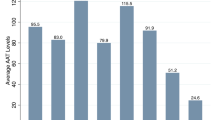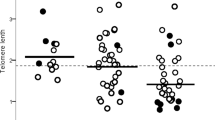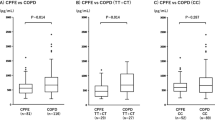Abstract
Chronic obstructive pulmonary disease (COPD) is a heterogeneous collection of conditions characterized by irreversible expiratory airflow limitation. The disease is interspersed with exacerbations; periods of acute symptomatic, physiological, and functional deterioration. The present study was designed to investigate the role of X-ray cross-complementing group 1 (XRCC1) and apurinic/apyrimidinic endonuclease 1 (APE1) polymorphisms and the risk of COPD. Blood samples from 354 unrelated subject (age range 18–60 years; 156 with COPD, 198 healthy controls) were collected. Genomic DNA was isolated and genotyped for XRCC1 Arg399Gln and APE1 Asp148Glu using a confronting two pair primers polymerase chain reaction. GA genotype of XRCC1 gene was found to be predominant in the COPD group compared to controls with 1.86-fold increased risk for COPD (OR 1.86, 95 % CI 1.20–2.88, p = 0.0013). TG genotype of APE1 was found to be predominant in COPD group compared to controls with the difference being statistically significant (OR 1.68, 95 % CI 1.08–2.61, p = 0.0043). The GA haplotype was found to be predominant in COPD than controls with a 2.19-fold significant increase (OR 2.19, 95 % CI 1.46–3.28, p = 0.003). Polymorphism in XRCC1 and APE1 gene is associated with an increased risk of COPD.


Similar content being viewed by others
References
Vestbo, J. 2013. “definition and overview”. global strategy for the diagnosis, management, and prevention of chronic obstructive pulmonary disease. Global Initiative for Chronic Obstructive Lung Disease. 1–7.
Vispe, S., T.M. Yung, J. Ritchot, H. Serizawa, and M.S. Satoh. 2000. A cellular defense pathway regulating transcription through poly (ADP-ribosyl) ation in response to DNA damage. Proceedings of the National Academy of Sciences of the United States of America 97: 9886–9891.
Altieri, F., C. Grillo, M. Maceroni, and S. Chichiarelli. 2008. DNA damage and repair: from molecular mechanisms to health implications. Antioxidants and Redox Signaling 10(5): 891–937.
Goode, E.L., C.M. Ulrich, and J.D. Potter. 2002. Polymorphisms in DNA repair genes and association with cancer risk. Cancer Epidemiology, Biomarkers and Prevention 11: 1513–1530.
Yin, J. 2007. The DNA, repair gene XRCC1 and genetic susceptibility of lung cancer in a northeastern Chinese population. Lung Cancer 56(2): 153–160.
Hang, B. 2010. Formation and repair of tobacco carcinogen-derived bulky DNA adducts. Journal of Nucleic Acids. 709521.
Yang, S.-F., Y.-J. XU, J.-G. Xie, and Z.-X. Zhang. 2009. hOGG1 Ser326Cys and XRCC1 Arg399Gln polymorphisms associated with chronic obstructive pulmonary disease. Chinese Medical Journal 122(8): 960–966.
Skjelbred, C.F., M. Saebo, H. Wallin, B.A. Nexo, P.C. Hagen, I.M. Lothe, et al. 2006. Polymorphisms of the XRCC1, XRCC3 and XPD genes and risk of colorectal adenoma and carcinoma, in a Norwegian cohort: A case control study. BMC Cancer 6: 67.
Caldecott, K.W., C.K. McKeown, J.D. Tucker, S. Ljungquist, and L.H. Thompson. 1994. An interaction between the mammalian DNA repair protein XRCC1 and DNA ligase III. Molecular and Cellular Biology 14: 68–76.
Izumi, T., T.K. Hazra, and I. Boldogh. 2000. Requirement for human AP endonuclease 1 for repair of 3′-blocking damage at DNA single-strand breaks induced by reactive oxygen species. Carcinogenesis 21: 1329–1334.
Fortini, P., B. Pascucci, E. Parlanti, M. D’Errico, V. Simonelli, and E. Dogliotti. 2003. The base excision repair: mechanisms and its relevance for cancer susceptibility. Biochimie 85: 1053–1071.
Tell, G., G. Damante, D. Caldwell, and M.R. Kelley. 2005. The intracellular localization of APE1/Ref-1: more than a passive phenomenon? Antioxidants and Redox Signaling 7: 367–384.
Evans, A.R., M. Limp-Foster, and M.R. Kelley. 2000. Going APE over ref-1. Mutation Research 461: 83–108.
Chiu, H.Y., L.V. Tsao, and R.C. Yang. 2009. Heat-shock response protects peripheral blood mononuclear cells (PBMCS) from hydrogen peroxide-induced mitochondrial disturbance. Cell Stress Chaperones 14: 207–217.
Berndt, I.S., Y.W. Huang, M.D. Fallin, J.K. Helzlsouer, A.E. Platz, L.J. Weissfeld, et al. 2007. Genetic variation in base excision repair genes and the prevalence of advanced colorectal adenoma. Cancer Research 67: 1395–1404.
Krupa, R., and J. Blasiak. 2004. An association of polymorphism of DNA repairs genes XRCC1 and XRCC3 with colorectal cancer. Experimental & Clinical Cancer Research 23: 285–294.
Li, C., Z. Liu, L.E. Wang, S.S. Strom, J.E. Lee, J.E. Gershenvald, et al. 2006. Genetic variants of the ADPRT, XRCC1 and APE1 genes and risk of cutaneous melanoma. Carcinogenesis 27: 1894–1901.
Bardia, A., S.K. Tiwari, S. Gunisetty, F. Anjum, P. Nallari, M.A. Habeeb, et al. 2012. Functional polymorphisms in XRCC-1 and APE-1 contribute to increased apoptosis and risk of ulcerative colitis. Inflammation Research 61(4): 359–365.
Odemis, S., E. Tuzun, H. Gulec, U.B. Semiz, S. Dasdemir, M. Kucuk, et al. 2016. Association between polymorphisms of DNA repair genes and risk of schizophrenia. Genetic Testing and Molecular Biomarkers 20(1): 11–17.
Silva, A.L.G.D., H.T.D. Rosa, T.E. Karnopp, C.F. Charlier, J.H. Ellwanger, D.J. Moura, et al. 2013. Evaluation of DNA damage in COPD patients and its correlation with polymorphisms in repair genes. BMC Medical Genetics 14: 93.
Ito, H., K. Matsuo, and N. Hamajima. 2004. Gene environment interactions between the smoking habit and polymorphisms in the DNA repair genes, APE1 Asp148Glu and XRCC1 Arg399Gln, in Japanese lung cancer risk. Carcinogenesis 25: 1395–1401.
Shen, M., R.J. Hung, P. Brennan, C. Malaveille, F. Donato, D. Placidiv, et al. 2003. Polymorphisms of the DNA repair genes XRCC1, XRCC3, XPD, interaction with environmental exposures, and bladder cancer risk in a case-control study in northern Italy. Cancer Epidemiology, Biomarkers and Prevention 12: 1234–1240.
Halliwell, B., and J.M. Gutteridge. 1999. Free radicals in biology and medicine, 3rd ed, 50–70. London: Oxford University Press.
Brody, J.S., and A. Spira. 2006. Chronic obstructive pulmonary disease, inflammation, and lung cancer. Proceedings of the American Thoracic Society 3: 535–537.
Chen, S., D. Tang, K. Xue, L. Xu, G. Ma, Y. Hsu, et al. 2002. DNA repair gene XRCC1 and XPD polymorphisms and risk of lung cancer in a Chinese population. Carcinogenesis 23: 1321–1325.
Matullo, G., D. Palli, M. Peluso, S. Guarrera, S. Carturan, E. Celentano, et al. 2001. XRCC1, XRCC3, XPD gene polymorphisms, smoking and (32)P-DNA adducts in a sample of healthy subjects. Carcinogenesis 22: 1437–1445.
Shen, H., Y. Xu, Y. Qian, R. Yu, Y. Qin, L. Zhou, et al. 2000. Polymorphisms of the DNA repair gene XRCC1 and risk of gastric cancer in a Chinese population. International Journal of Cancer 88: 601–606.
Zhou, W., G. Liu, D.P. Miller, S.W. Thurston, L.L. Xu, J.C. Wain, et al. 2003. Polymorphisms in the DNA repair genes XRCC1 and ERCC2, smoking, and lung cancer risk. Cancer Epidemiology, Biomarkers and Prevention 12: 359–365.
Kasahara, M., K. Osawa, and K. Yoshida. 2008. Association of MUTYH Gln324His and APEX1 Asp148Glu with colorectal cancer and smoking in a Japanese population. Journal of Experimental & Clinical Cancer Research 27: 1–8.
Shen, M., S.I. Berndt, and N. Rothman. 2005. Polymorphisms in the DNA base excision repair genes APE1and XRCC1 and lung cancer risk in Xuan Wei, China. Anticancer Research 25: 537–542.
Acknowledgments
The study was not supported by any intramural or extramural funds.
Author information
Authors and Affiliations
Corresponding author
Ethics declarations
Conflict of interest
The authors hereby declare no conflict of interest.
Rights and permissions
About this article
Cite this article
Bardia, A., Vishwakarma, S.K., Reddy, C.L. et al. Genetic Polymorphisms of X-ray Repair Cross-Complementing Group 1 and Apurinic/Apyrimidinic Endonuclease-1 in Chronic Obstructive Pulmonary Disease. Inflammation 39, 1198–1204 (2016). https://doi.org/10.1007/s10753-016-0355-x
Published:
Issue Date:
DOI: https://doi.org/10.1007/s10753-016-0355-x




